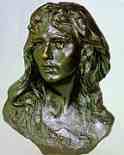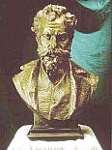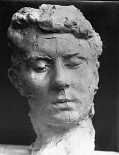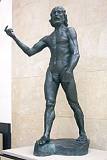AUGUSTE RODIN
- his life, his work (2)
|
|
|
|
|
1865
|
 With Dalou, he works on the decoration of Hôtel de la Païva. With Dalou, he works on the decoration of Hôtel de la Païva.
In his own studio, he works on 'Young Lady with Flower Hat' and the lifesize 'Bacchante' (destroyed), for which Rose Beuret was the
model.
|
|
18.1.1866
|
Auguste-Eugène Beuret is the first child of Rose and Auguste.
In his first years of life, the child suffers a severe head injury when falling through a
window, his mental faculties do not develop normally; thus he will never reach his
father's artistic expectations.
Rodin starts the bust of Mme Cruchet.
|
|
31.8.1867
|
Charles Baudelaire dies at the age of 46.
|

|
|
1869
|
Rodin works on 'Mother and Child', 'Mignon'.
|
|
1870
|
He executes the busts of Mr and Mrs Garnier.
Beginning of the Franco-Prussian War: Rodin is enrolled in a pioneer unit in the
national guards.
|
|
1871
|
Rodin being shortsighted, he is declared as unfit for
military duty and travels to Brussels together with Carrier-Belleuse in order to perform decorative work at the
Palais de la Bourse.
|
|
|
Rose remains in Paris with their young son. Year of the Paris Commune.
When Rodin's mother dies, Rose also takes care of Rodin's father.
In Brussels, Carrier-Belleuse does not appreciate Rodin's efforts to sell
work under his own name and dismisses Rodin. On 16 May 1871 Carrier returns to Paris.
|
|
1872
|
 Rose follows Rodin to Brussels. Their son Auguste-Eugène and Rodin's
father, who is getting blind and senile, are left in Paris in the care of
Thérèse Dubois and her son Auguste Cheffer, son in law of Rodin's uncle
Jaques-Alexandre Rodin.
Rose follows Rodin to Brussels. Their son Auguste-Eugène and Rodin's
father, who is getting blind and senile, are left in Paris in the care of
Thérèse Dubois and her son Auguste Cheffer, son in law of Rodin's uncle
Jaques-Alexandre Rodin.
Rose and Rodin live in a room at 346, Chaussée de Wavre in
Etterbeek.
Rodin models 'Suzon' and 'Dosia'; the Compagnie des Bronzes purchases both
works and casts them in large
quantities.
Bust of 'Doktor
Thiriard'.
|
|
1872-75
|
 Even if Rose and Auguste are still very poor, they enjoy living at
Brussels. During extensive stays in the Bois de Soignes Rodin executes
a few oil paintings. He also makes some lithographs to illustrate the satirical magazine
Le Petit Comique. Even if Rose and Auguste are still very poor, they enjoy living at
Brussels. During extensive stays in the Bois de Soignes Rodin executes
a few oil paintings. He also makes some lithographs to illustrate the satirical magazine
Le Petit Comique.
Rodin moves to the Belgian sculptor Antoine van Rasbourg for whom he
creates a number of sculptures in a manner close to Michelangelo.
He takes part in a few architectural projects: three caryatids for a house on the
Boulevard Anspach, together with Van Rasbourg he executes the 'Allegory of the Arts and Sciences' for the
Palais des Académies, two bas-reliefs for the Palais Royal, some figures for the
Conservatory of Music and a monument for Jean-Francois Loos, the former mayor
of Antwerp.
|
|
1875/76
|
 To
make himself a name as an artist, he starts working on an uncommisioned
standing figure, 'The Age of Bronze' after studies of
a Belgian soldier named Auguste Neyt. To
make himself a name as an artist, he starts working on an uncommisioned
standing figure, 'The Age of Bronze' after studies of
a Belgian soldier named Auguste Neyt.
He departs to Italy – Torino, Genova, Pisa, Florence, Rome, Naples; Rose stays in Brussels; profound study of works of Michelangelo.
After his return to Brussels he executes 'The Age of Bronze'.
He destroys the outlines of 'Adam' and 'Ugolino with three sons'
except for the bodies of the main figures.
|
|
1877
|
In Brussels, Rodin exhibits 'The Age of Bronze' - which he calls
'The Conquered Man'
- at the
Cercle Artistique, afterwards at the Salon but without the lance in
the left hand. At both occasions, it is suggested he has used plaster casts from life, the first
'Affaire Rodin'. In March, he travels to Paris to prepare the
submission of the sculpture to the Salon and uses the studio of his
friend Victor Tournier at 3 Rue des Bretonvillers on the Ile
Saint-Louis.
Although the 'Age of Bronze' is admitted to the Salon, Rodin has to
learn that the rumours from Belgium have followed him to Paris. Rodin asks
the chairman of the jury, Eugène Guillaume, director of the École des
Beaux-Arts, for a chance to clear his reputation:
"Owing to these terrible doubts raised by the jury,
I find myself robbed of the fruits of my labors. Contrary to what people
think I did not cast my figure from the model but spent a year and a half
on it; during that time my model came to the studio almost constantly.
Moreover I have spent my savings working on my figure, which I had hoped
would be as much of a success in Paris as it was in Belgium since the
modeling seems good - it is only the procedure that has been attacked. How
painful it is to find that my figure can be of no help to my future; how
painful to see it rejected on account of a slanderous suspicion!"
His Belgian friends Félix Bouré and Gustave Biot
contribute testimonies that they had watched Rodin work on his figure only
from the living model. He also has photos made of
Auguste Neyt and his sculpture, to demonstrate that the accusations raised
in the Étoile Belge are false, but his evidence is completely ignored by the
jury. The sculpture receives a positive response from other artists,
though.
With Rose, Rodin returns to Paris for good. They live in a cheap
appartement in the Rue Fossé St. Jaques, at the corner of the Rue
Royer-Collard. His father and his son come to live with them. Later
they will move to Nr. 268 in the same street.
Over the next three years, Rodin works for Carrier-Belleuse again, as an
anonymous modeler for a minimal pay.
Studies of 'St. John the Baptist Preaching' in monumental size to avoid the accusation
related to 'The Age of Bronze'. Later, Rodin explains to his friend Gsell
how he created the suggestion of movement:
"(The sculptor) represents the transition from one pose to another
- he indicates how insensibly the first glides into the second. In his
work we still see a part of what was and we discover a part of what is to
be. (..).  Now, for example, while my Saint John is represented with both
feet on the ground, it is probable that an instantaneous photograph from a
model making the same movement would show the back feet already raised and
carried forward to the other.(..) Now it is exactly for that reason that
this model photographed would present the odd appearance of a man suddenly
stricken with paralysis and petrified in his pose. (..) It is the artist
who is truthful and it is photography which lies, for in reality time does
not stop, and if the artist succeeds in producing the impression of a
movement which takes several moments for accomplishment, his work is
certainly much less conventional than the scientific image, where time is
abruptly suspended."
Now, for example, while my Saint John is represented with both
feet on the ground, it is probable that an instantaneous photograph from a
model making the same movement would show the back feet already raised and
carried forward to the other.(..) Now it is exactly for that reason that
this model photographed would present the odd appearance of a man suddenly
stricken with paralysis and petrified in his pose. (..) It is the artist
who is truthful and it is photography which lies, for in reality time does
not stop, and if the artist succeeds in producing the impression of a
movement which takes several moments for accomplishment, his work is
certainly much less conventional than the scientific image, where time is
abruptly suspended."
Rodin meets Jules Desbois, to whom he keeps an intimate friendship.
|


|